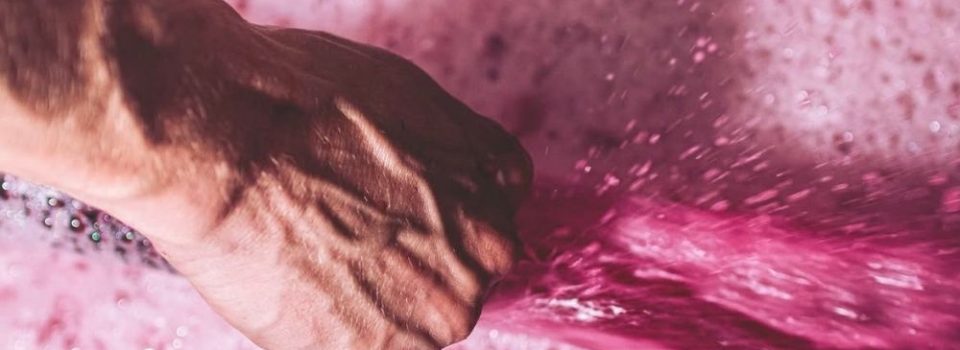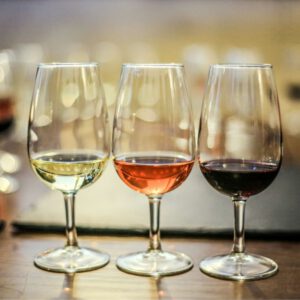Grenache, also known as Garnacha in Spain or Cannonau in Sardinia, is one of the most iconic and versatile grape varieties in the world of wine. Originally from Spain, it gradually established itself in the South of France, particularly in the Rhône Valley, Languedoc, and Provence, and today it has spread to sun-drenched regions in Australia and California.
Renowned for its ability to produce intense red wines, fresh rosés, and complex fortified wines, this grape variety captivates both with its diversity and its aromatic finesse. Its notes of red fruits, spices, and occasionally jammy nuances make it an ideal grape for blends, while also revealing its full potential in single-varietal wines, producing rich, balanced, and truly Mediterranean expressions.
In this article, we offer a comprehensive overview of Grenache: its history, its emblematic terroirs, its organoleptic characteristics, the styles of wine it produces, ideal food pairings, and current market trends. You will also discover why training on this grape with Weeno can enhance your expertise and open new professional opportunities in the wine industry.
Ready to dive deep into Grenache and expand your knowledge? Join us on this journey into one of the world’s most essential grape varieties.
1. History and origin of Grenache
Grenache is a grape variety with a fascinating Mediterranean journey, which has established itself as one of the most iconic in the world. Its origins trace back to Spain, specifically the Aragon region, where it is known as Garnacha. It quickly spread to the South of France, particularly the Rhône Valley, Languedoc, and Provence, where it became a cornerstone of blends and emblematic wines of these terroirs.
A rich history and lasting popularity
Grenache has endured through the centuries, prized for its heat resistance and its ability to produce generous, aromatic wines. Introduced to France as early as the 14th century, it quickly became an integral part of the famous Châteauneuf-du-Pape blends, playing a central role by contributing richness, roundness, and fruity aromas.
Its popularity has never waned: today, it is one of the most widely planted red grape varieties in the world, used for powerful, structured reds, fresh and light rosés, as well as fortified wines such as Banyuls or Maury.
Anecdotes and role in great wines
It is often at the heart of Mediterranean blends, providing fruitiness, suppleness, and warmth to the wines. In prestigious Châteauneuf-du-Pape wines, it is frequently blended with Syrah and Mourvèdre to create complex and harmonious wines.
In Spain, single-varietal Garnacha wines can reach remarkable levels of concentration and finesse, demonstrating the versatility of this historic grape. Garnacha in Spain is often blended with Tempranillo or Carignan.
In summary, Grenache is much more than a simple grape: it embodies Mediterranean wine culture, a historical legacy that continues to inspire winemakers and wine enthusiasts worldwide.
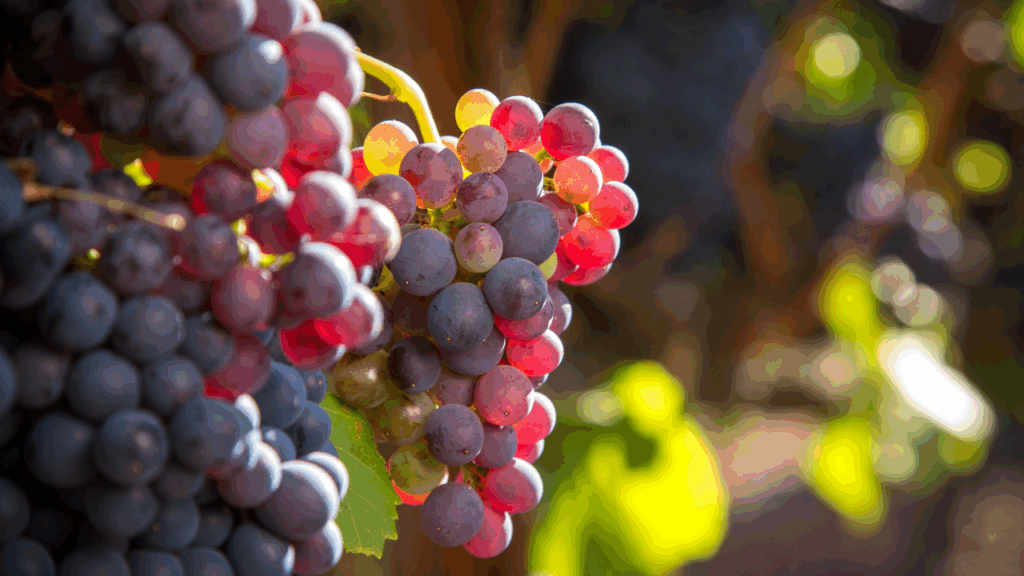
2. Characteristics of the Grenache grape variety
It is a generous and adaptable grape variety, whose agronomic and oenological traits explain its popularity throughout the Mediterranean basin.
Vine morphology
The Grenache vine is vigorous and can produce high yields, making it highly prized by growers, but it requires careful management to limit overproduction and concentrate its aromas.
However, it is sensitive to diseases, particularly powdery mildew and downy mildew, and needs a warm, sunny climate to fully express its potential. Well-drained soils, often stony or clay-limestone, allow this grape to develop its typicity and aromatic richness.
Aromas and winemaking profile
Grenache produces intense and appealing wines, with a highly recognizable aromatic palette:
- Red fruits: strawberry, raspberry, cherry
- Sweet spices: cinnamon, white pepper
- Jammy notes: particularly in wines grown in warm climates or in fortified wines
Thanks to its soft body and round texture, it can be vinified in several ways:
- Single-varietal wines, to showcase its fruity richness and generosity
- Blends, notably with Syrah and Mourvèdre, to add complexity, structure, and balance
Its aging potential is also noteworthy. While often enjoyed young for its fresh, fruity aromas, it can age for several years, developing more complex notes of cooked fruits, spices, and leather in premium wines.
Styles of wines produced
Grenache is extremely versatile, which explains its use in different wine styles:
- Red wines: Often blended in the Rhône Valley, Languedoc, or Spain, but also as a single varietal, producing powerful and aromatic wines
- Rosé wines: Widely planted in Provence and Spain, yielding fresh, fruity, and elegant rosés
- Fortified wines: Grenache is the base of famous fortified wines such as Banyuls and Maury, where it reveals exceptional jammy and spicy aromas
In summary, Grenache combines aromatic richness, a smooth mouthfeel, and versatility in winemaking, making it an essential grape for wine lovers and professionals in the Mediterranean wine world.
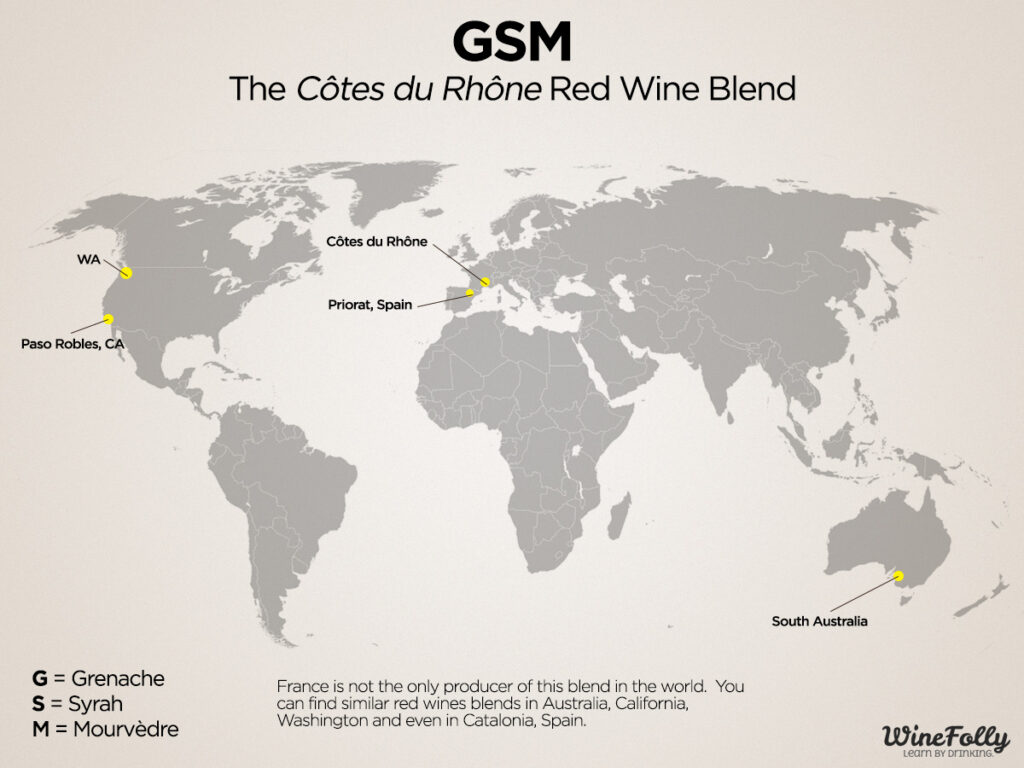
3. Iconic terroirs of Grenache
This is a quintessential Mediterranean grape, expressing itself differently depending on climate, soil, and local winemaking traditions. Its versatility allows it to adapt to many terroirs, but it reaches its peak in warm, sunny regions.
France: The birthplace of great blends
- Châteauneuf-du-Pape: In this iconic Rhône appellation, Grenache is the dominant grape in the blends, providing power, roundness, and aromas of jammy red fruits and sweet spices. The stony soils (galets roulés) and the hot, dry climate allow Grenache to fully ripen.
- Côtes du Rhône: Here, it brings fruitiness and suppleness to blends with Syrah and Mourvèdre, producing elegant wines that are approachable even in their youth.
- Languedoc and Roussillon: These southern regions use Grenache for fruity reds and rosés, as well as for the famous fortified wines such as Banyuls and Maury. In these terroirs, it often expresses notes of cherry, raspberry, and licorice.
Spain: The historical soul
- Rioja: Locally known as Garnacha, it provides roundness and fruitiness to traditional blends with Tempranillo, producing balanced and fruity red wines.
- Priorat: Wines from this region are powerful and concentrated, thanks to the slate soils and the hot, dry Mediterranean climate. Grenache here reveals intense aromas of black fruits and spices, with a solid tannic structure.
- Navarra: it produces fresh, aromatic reds and rosés, lighter and more approachable, often used for everyday drinking wines.
New World: Australia and California
- Australia (McLaren Vale, Barossa Valley): it produces generous, round, and fruity wines, often vinified as a single varietal or blended with Shiraz and Mourvèdre (GSM style). The warm, dry climates allow Grenache to develop ripe red fruit aromas and soft spice notes.
- California (Paso Robles, Santa Barbara): it expresses intense fruitiness and a smooth mouthfeel, suitable for fruity reds or Mediterranean-style rosés.
Influence of climate and soils
Grenache’s aromatic profile is strongly influenced by its terroir:
- Warm, dry Mediterranean climate → optimal grape ripening, jammy aromas, higher alcohol content
- Stony or clay-limestone soils → finesse and balanced structure
- Slate soils (Priorat) → power, concentrated aromatics, and complexity for aging
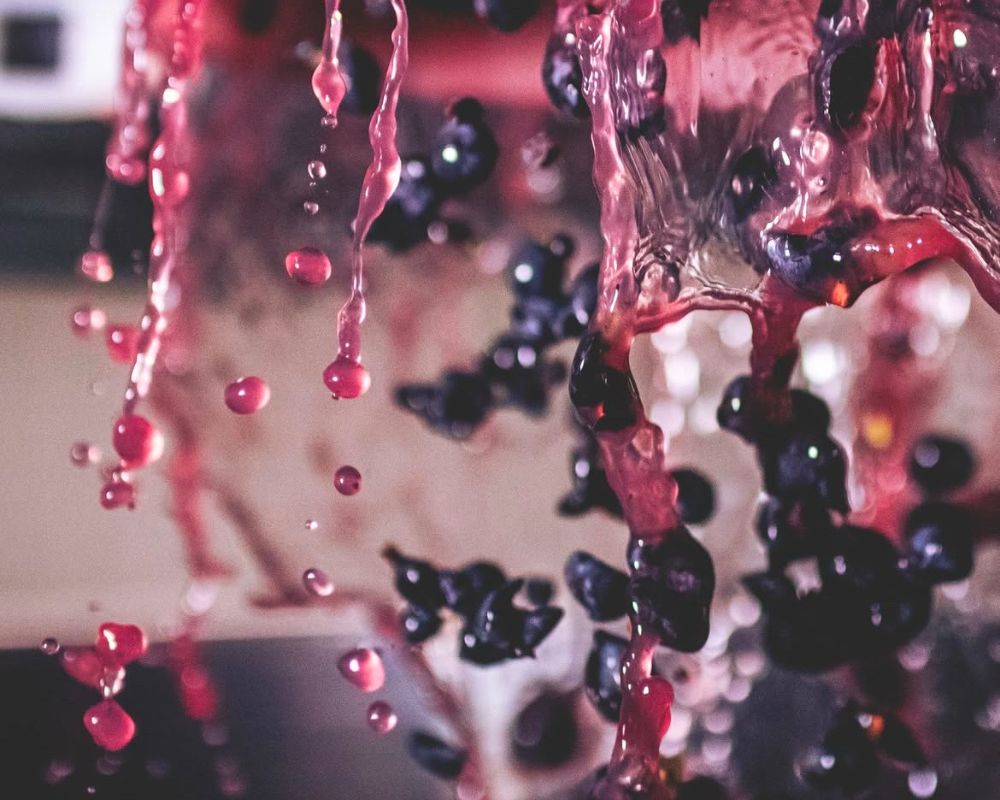
4. Vinification and specific techniques of Grenache
It is a delicate grape to vinify due to its thin skin and high sugar content. To produce balanced and expressive wines, winemakers adapt their methods depending on the desired wine style, terroir, and grape ripeness.
Harvesting: Manual vs. mechanical
- Manual harvesting: Favored in prestigious appellations such as Châteauneuf-du-Pape or Priorat, manual picking allows winemakers to select only perfectly ripe bunches and avoid premature crushing, which is essential to preserve freshness and aromatic purity.
- Mechanical harvesting: Common in large production regions (Languedoc, Australia, California), it enables rapid collection of large quantities but requires careful handling to avoid oxidation and unwanted aromas.
Maceration, fermentation, and aging
- Maceration: Red Grenache may require shorter maceration periods than Syrah to prevent overly aggressive tannins while retaining bright fruitiness.
- Fermentation: Can take place in stainless steel tanks, concrete vats, or barrels, depending on the aromatic goal. Controlled temperatures are crucial to preserve red fruit and spice aromas.
- Aging: Traditionally in vats or large foudres, aging can last from a few months to several years, especially for Châteauneuf-du-Pape blends. Grenache responds well to used barrels, which add complexity without masking the fruit.
Typical blends
Grenache is often blended with other grapes to provide balance and structure:
- Syrah: Adds color, tannic structure, and spice.
- Mourvèdre (Monastrell in Spain): Enhances power and longevity.
- Carignan: Contributes acidity and rusticity, especially in Southern France.
These blends, often referred to as GSM (Grenache-Syrah-Mourvèdre), are emblematic of Mediterranean red wines, producing harmonious and complex results.
Modern techniques and innovations
Contemporary winemakers experiment with techniques to optimize Grenache expression:
- Micro-oxygenation: Improves tannin structure and stability while enhancing roundness.
- Barrel aging (new or used): Depending on the aromatic goal, it can add toasted or vanilla notes or simply structure the wine without overwhelming the fruit.
- Precise temperature and extraction control: Helps avoid overly alcoholic or heavy wines while preserving the grape’s fruity and spicy character.
Thanks to these methods, Grenache can produce powerful reds, fruity rosés, or complex fortified wines while staying true to its typical aromatic profile of red fruits and spices.
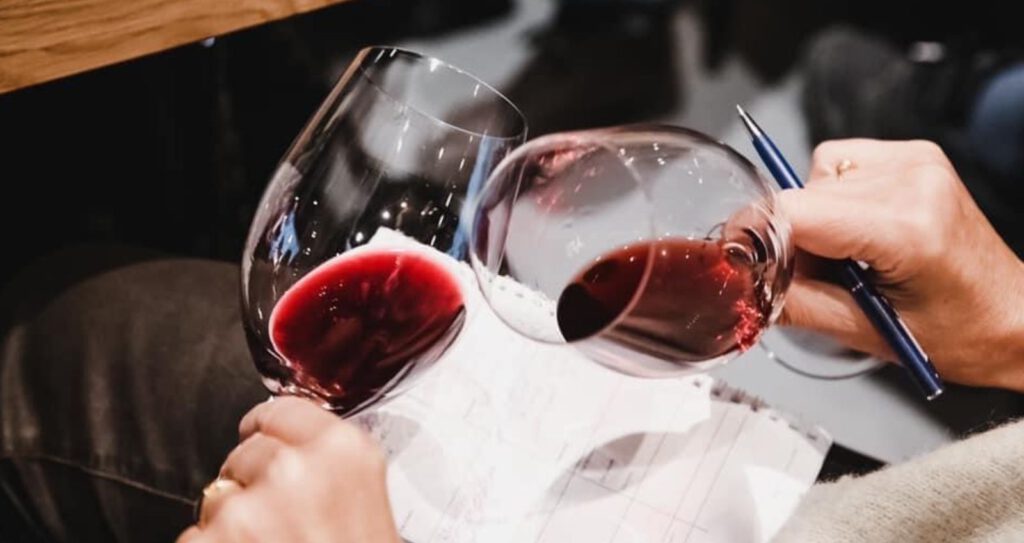
5. Sensory analysis and tasting of Grenache
Grenache is a grape known for its smoothness and generous aromatic expression, but its characteristics vary depending on the terroir, climate, and winemaking style. Understanding its sensory profile is essential for wine professionals, sommeliers, and knowledgeable enthusiasts.
To learn how to taste your glass of Grenache like a pro, download the WSET systematic tasting sheet here.
Appearance
- Reds: Grenache produces wines ranging from ruby red to garnet, often lighter than Syrah or Mourvèdre, reflecting its delicacy and finesse.
- Rosés: Peach to raspberry shades, bright and luminous, ideal for wines from Provence or Spain.
- Fortified / Sweet Wines: Amber to deep purple depending on winemaking and aging, such as in fortified wines like Banyuls or Maury.
Nose
Grenache has a broad and seductive aromatic profile:
- Fresh red fruits: Strawberry, cherry, raspberry.
- Ripe dark fruits: Blueberry, blackberry (especially in warmer climates like Australia or California).
- Spices and jammy notes: White pepper, cinnamon, hints of licorice or candied orange depending on aging and ripeness.
- Terroir influence: Pebble-strewn soils (Châteauneuf-du-Pape) contribute forest floor and mineral nuances, while clay-limestone soils (Priorat) enhance concentration and aromatic intensity.
Palate
- Texture: Silky and smooth, with moderate structure (light to medium tannins), making Grenache very approachable when young.
- Acidity: Low to medium, higher in cooler regions like parts of Roussillon, providing freshness and balance.
- Body and alcohol: Grenache tends to produce wines with noticeable alcohol, especially in warm climates where sugars accumulate rapidly, giving roundness and volume on the palate.
- Finish: Persistent, fruity, and often spicy, leaving an impression of sweetness and indulgence.

6. Food pairings with Grenache
Grenache is a versatile grape that lends itself to a wide range of pairings thanks to its smoothness, fruitiness, and spicy notes. Whether red, rosé, or sweet, understanding the style and origin enhances the tasting experience.
Red wines: Warmth and generosity
Red Grenaches, whether single-varietal or blends, pair perfectly with:
- Grilled meats: lamb, pork, herb-roasted chicken, ribeye steak.
- Mediterranean dishes: ratatouille, tagine, moussaka.
- Tapas and charcuterie: Iberian ham, chorizo, black olives.
Weeno Tip: Favor young wines from warm regions (Roussillon, Priorat) for intense fruitiness and spice, while older Châteauneuf-du-Pape wines bring complex terroir notes, ideal for stews and saucy dishes.
Rosés: Freshness and lightness
Grenache rosés, typical of Provence or Spain, are fresh and fruity, pairing ideally with:
- Grilled fish: sea bream, salmon, sardines.
- Summer salads: Niçoise, tabbouleh, grilled vegetable salads.
- Light tapas: stuffed tomatoes, vegetables with olive oil.
Weeno Tip: Serve well chilled (10–12°C / 50–54°F) to enhance fruitiness and liveliness while balancing natural acidity with light dishes.
Sweet wines: Indulgence and complexity
Sweet Grenaches or Vin Doux Naturel (Banyuls, Maury) develop notes of candied fruits, spices, and cocoa, perfect for:
- Fruit desserts: red fruit tarts, clafoutis, nutty fruit crumbles.
- Foie gras: a sweet-salty contrast highlighting the wine’s richness.
- Dark chocolate: sweet Grenache reveals roasted and spicy notes, ideal with high-cocoa chocolate.
Weeno Tip: Serve sweet wines slightly chilled (12–14°C / 54–57°F) to maintain sugar-acid balance while fully expressing the wine’s complex aromatic profile.
Expert Weeno advice
To optimize your pairings:
- Identify the style and origin: Mediterranean Grenache = fruity; Southern Grenache = powerful and spicy.
- Play with intensity: light wines for simple dishes, structured wines for rich and spicy meals.
- Consider acidity and tannins: Grenache’s roundness pairs perfectly with soft textures or lightly spiced dishes.
Thanks to this versatility, Grenache can enhance your meals from aperitif to dessert while showcasing the richness and diversity of the terroirs where it is grown.
Want to master Grenache pairings? They are part of our WSET courses — find all details here.
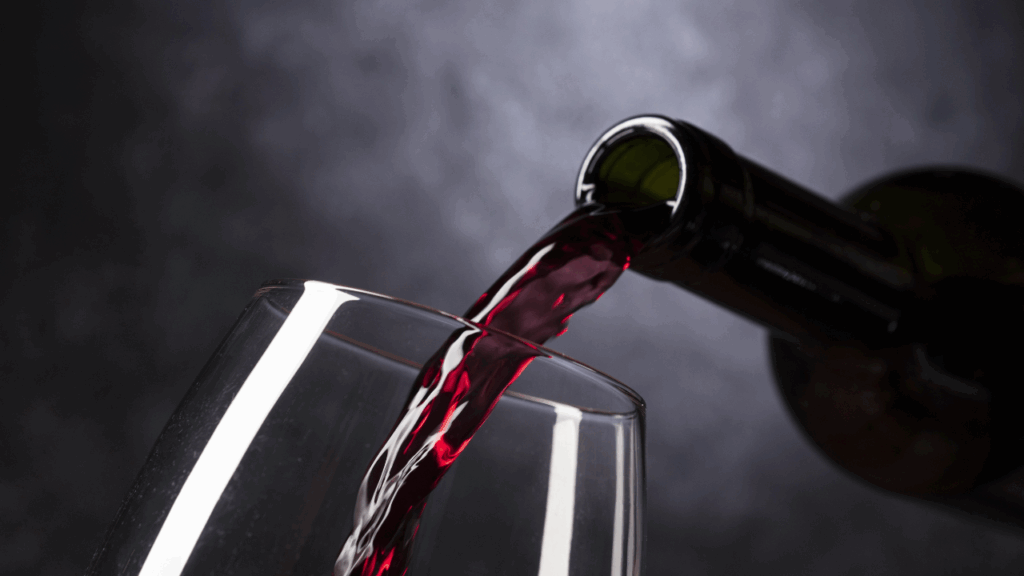
7. Trends and market for Grenache
Grenache is a grape variety experiencing renewed interest both in France and internationally. Its versatility and aromatic expression are increasingly attracting wine enthusiasts, sommeliers, and industry professionals.
Popularity in France and internationally
In France, Grenache remains a cornerstone of southern appellations: Châteauneuf-du-Pape, Côtes du Rhône, Roussillon, and Provence. Its ability to produce powerful reds, fresh rosés, and sweet natural wines makes it an essential grape for consumers and export markets alike.
Internationally, Grenache is gaining momentum:
- Spain: Priorat and Navarra highlight single-varietal Grenache wines. Wines from old Grenache vines in the Catalayud appellation are particularly noted for their minerality and elegance.
- Australia and California: New World Grenaches appeal with intense fruitiness and a modern style, attracting younger and curious audiences.
This international dynamic demonstrates that Grenache is no longer just a blending grape but is increasingly recognized as a varietal wine in its own right, celebrated for its typicity and aromatic diversity.
Single-Varietal wines vs blends
Traditionally, Grenache was mainly used in blends with Syrah, Mourvèdre, or Carignan to bring suppleness, fruitiness, and roundness.
Today, there is a notable return to single-varietal Grenache:
- Pure red wines reveal fruity character, spice, and terroir.
- Single-varietal rosés highlight freshness and indulgence.
- Single-varietal sweet natural wines offer complexity and aromatic intensity.
This focus on single-varietal wines strengthens Grenache’s identity and recognition among consumers and critics alike.
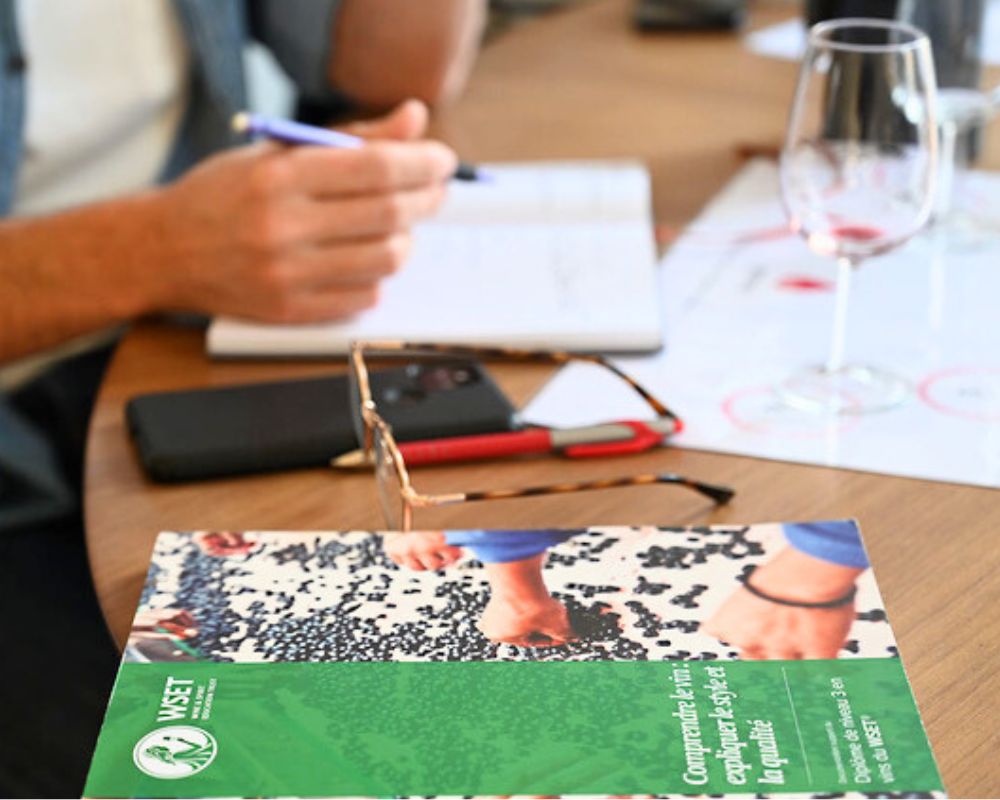
8. Why study Grenache with Weeno
Studying Grenache with Weeno is more than just learning about a grape variety: it is a true lever to develop your professional expertise and deepen your knowledge in oenology.
WSET expertise
Our programs are based on the WSET (Wine & Spirit Education Trust) framework, allowing you to:
- Master iconic grape varieties, such as Grenache, and their expression according to terroirs.
- Gain an in-depth understanding of aromas, sensory profiles, and wine styles.
- Develop critical analysis and tasting skills, essential for sommeliers, wine merchants, and wine professionals.
Practical and theoretical training
Weeno combines:
- Theoretical courses to understand the history, viticulture, winemaking, and market of Grenache.
- Hands-on workshops and tastings to apply your knowledge on wines from different regions and styles, from single-varietal to classic blends.
Professional development
Studying Grenache with Weeno enables you to:
- Leverage your knowledge for trade and export by mastering internationally sought-after grape varieties.
- Develop pedagogical expertise, ideal for teaching or training about wine.
- Strengthen your sommellerie skills and food & wine pairing knowledge, with a focus on a strategic and popular grape variety.
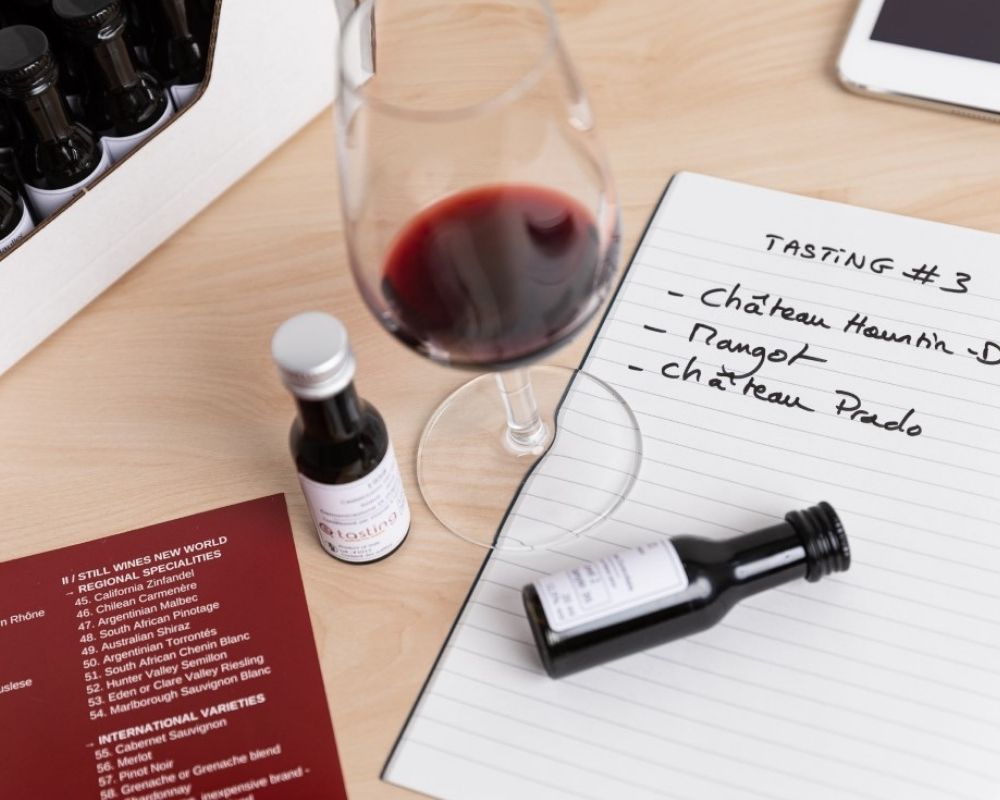
Grenache is much more than a simple grape variety: it is a major contributor to numerous red, rosé, and sweet wines around the world. Its versatility, rich aromatic profile, and ability to express itself according to terroir make it a strategic grape to know for any wine professional, from sommeliers to wine merchants, and even educators and informed enthusiasts.
To deepen your knowledge and develop your expertise, training with Weeno is the most effective path: you will learn to master Grenache, understand its subtleties, and use it as a real professional tool.
➡️ Discover our WSET courses and key grape varieties here: weenodrinksacademy.com/formations-wset
